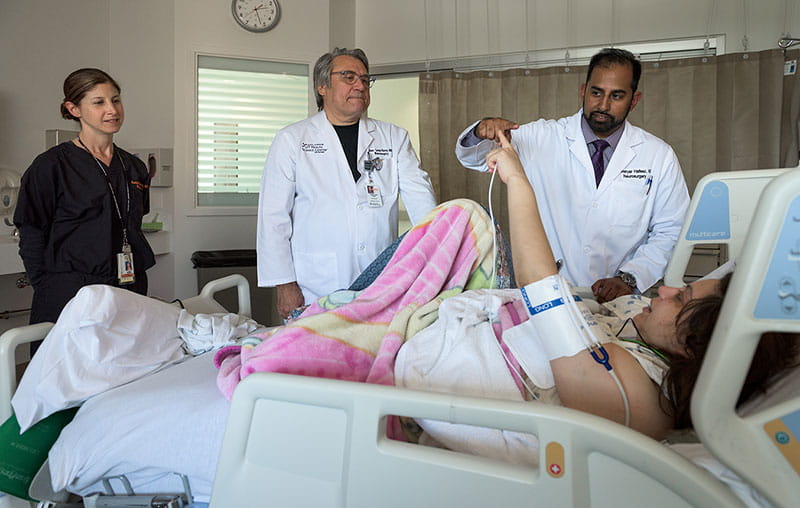Chrissy McCafferty Gibson initially thought her runny nose and slight cough were the result of allergies. Then she was hit with an intense headache and severe body aches and realized she had a more serious condition. Her head seemed like it was on fire.
“I felt like I had been beaten-up with a baseball bat,” she says.
That was how Gibson’s battle with the long-term effects of COVID-19 began in June of 2020. She tested positive for the virus and her primary care physician prescribed medication and nebulizer treatments she could administer at home.
The 41-year old bartender soon began feeling better. She thought she had recovered from the COVID-19 virus and was nearly ready to return to work when she was slammed with the first wave of neurological symptoms. They scrambled her memory, slurred her speech and forced her into a wheelchair. Her husband, an emergency medical technician, suspected she’d had a stroke and rushed her to a nearby hospital. Tests, however, showed no evidence of stroke and doctors couldn’t figure out what was happening to Gibson’s body.
It was a news report about a new clinic treating so-called long-haulers – former COVID-19 patients with long-term, destabilizing conditions – which led Gibson to Dr. Monica Verduzco-Gutierrez. Dr. Gutierrez, a physical medicine and rehabilitation specialist at University Health and UT Health San Antonio, had opened a post-COVID recovery clinic to treat patients just like Gibson. Four months had passed since Gibson felt the first effects of the virus. She was using a walker, had no taste or smell and still suffered from excruciating headaches when she saw Dr. Gutierrez for the first time.
“I was a shell of a person,” she recalls. “I couldn’t follow a thought. I couldn’t track a conversation.”
Long-haulers battle neurological conditions
By March of 2021, Dr. Gutierrez had assessed more than 200 patients with conditions that have lingered or emerged following a COVID-19 infection. Medical experts say the virus will seemingly attack any part of the body including the heart, lungs, kidneys and other major organs. However, at least one in three of Dr. Gutierrez’s post-COVID-19 patients is like Gibson. They’re experiencing symptoms related to brain function:
- “Brain fog,” and the inability to think clearly
- Dizziness
- Memory loss
- Tinnitus or ringing in their ears
- Tremors or loss of balance
“If you add in fatigue as a neurologic problem, almost all of them have that,” said Dr. Gutierrez of her post-COVID-19 patients.
Dr. Gutierrez’s observations track with one of the largest studies to date published in the Lancet Medical Journal. Researchers documenting the effects of the virus on 236,000 COVID-19 survivors found 34% of them had neurological or psychological symptoms within six months of having the virus. Those with the most serious post-COVID-19 problems had been hospitalized, but many like Gibson recovered from the virus at home and became chronically ill after that.
How does COVID-19 affect the brain?
Just how COVID-19 affects brain function is something scientists do not completely understand, though they are making some significant discoveries.
Researchers examining the effects of COVID-19 in mice found evidence the virus was actually entering the brain of the animals. Their observations, published in Nature Neuroscience on December 16, 2020, described the spike protein found on the SARS-CoV-2 virus crossing the blood-brain barrier, a permeable membrane that blocks many harmful substances from entering the brain.
In another study, scientists with the National Institutes of Health, NIH, examined the brains of 19 patients who died after battling COVID-19. They found abnormally thin blood vessels like you might see with stroke patients, but they did not detect the virus. They suspect the damage was related to inflammation.
“We found that the brains of patients who contract infection from SARS-CoV-2 may be susceptible to microvascular blood vessel damage,” said Dr. Avindra Nath, the clinical director at the National Institute of Neurological Disorders and Stroke and the senior author of the study.
“Our results suggest that this may be caused by the body’s inflammatory response to the virus,” Dr. Nath said in a press release.
Treating the neurological conditions
Unlocking the way COVID-19 disrupts brain function may lead to better prevention and treatment of neurological problems. In the meantime, Dr. Gutierrez says existing rehabilitation therapies can be effective. In the post-COVID-19 recovery program she began at University Health and UT Health San Antonio, Dr. Gutierrez prescribes some of the same treatments she’s found effective for patients who have not had the novel coronavirus.
“We do know these are disease states people have had with other illnesses. We know for fatigue you may need a gradual return to exercise programs. You may need medications. You may need something to optimize your sleep. If you have cognitive deficits, there are therapy techniques that can help with that,” she explains.
To minimize Gibson’s crippling headaches, Dr. Gutierrez has administered Botox injections which block nerve signals that cause facial muscles to contract. She has used long swabs that look like giant Q-tips to apply lidocaine jelly to the upper reaches of Gibson’s nasal passage. Lidocaine is a local anesthetic used to numb pain.
The treatments and physical therapy are helping, though Gibson says she still suffers from recurring waves of illness that immobilize her. In mid-April she had a “monster brain crash” that again disrupted her speech and balance for 10 days.
“Inside my head it was like fireworks were going off,” she says.
“I mourn for the life I used to have,” says Gibson who wants to return to work and do simple things like drive a car.





